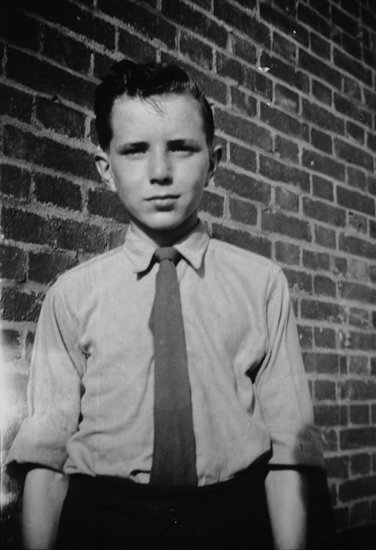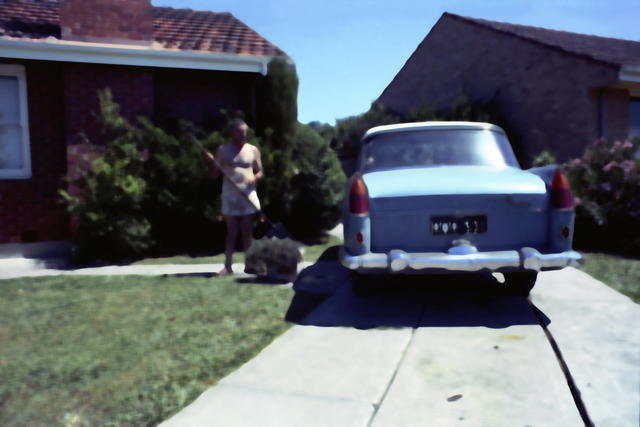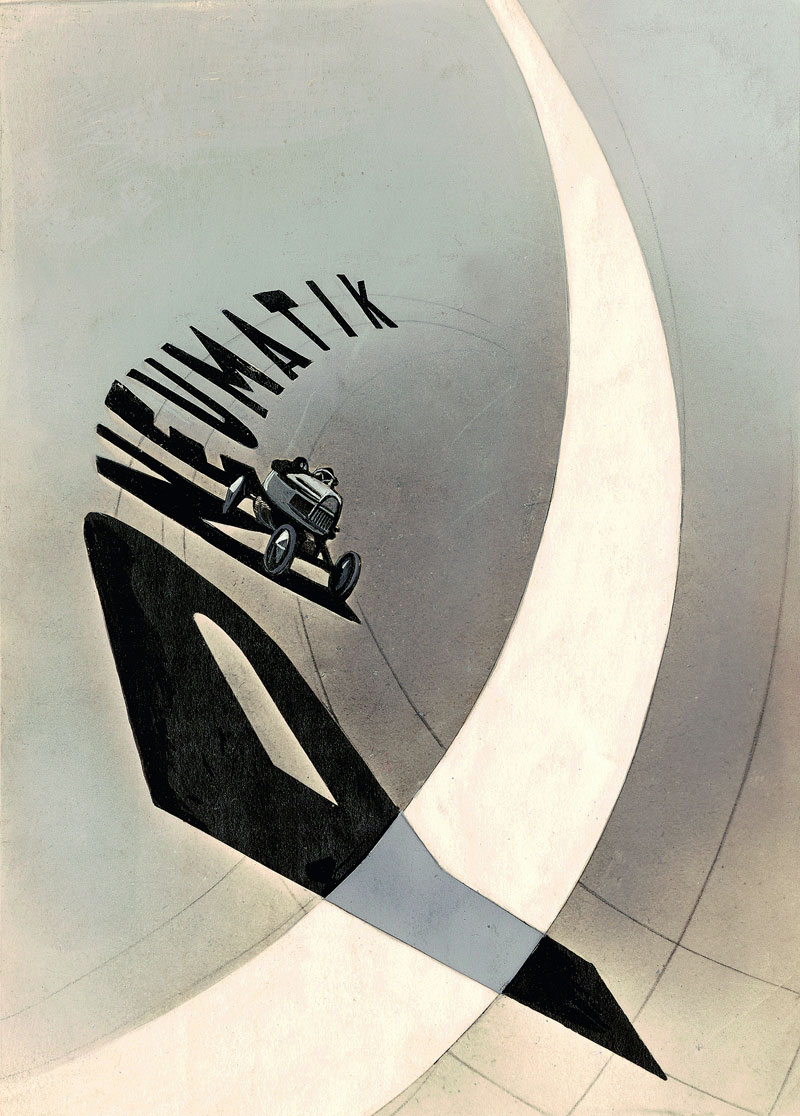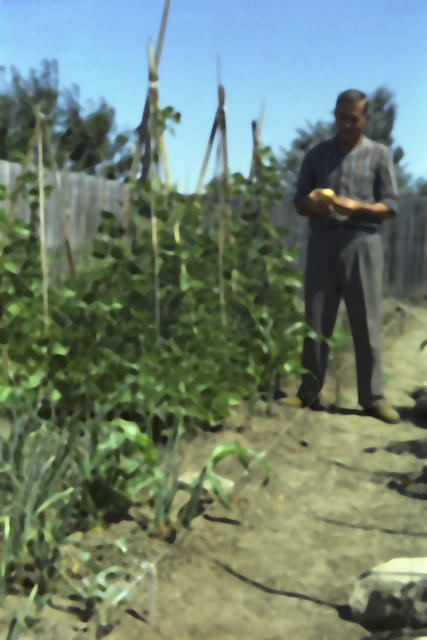Art and Documentary:
Photographic Biculturalism?
Originally published Photogenic, CCP (2005), essays 2002-2004
ARCADIA DEL SUD: West Heidelberg, Melbourne, Australia, circa 1966, the work of Domenico M. Cozzolino, winner of the 2003 Leica/CCP Documentary Photography Award, tells a story in retrospect of his Napolese migrant parents re-rooting to 'New Australian' suburbia.1
The work takes the form of a suite of eight colour photographs digitally reconstructed from the artist's own cache of his teenage colour snapshots.2 Thus, although unconventionally manipulated for documentary style work, Arcadia del Sud nevertheless takes its place in a long tradition of the allure of the naif family snap in photographic and art histories.
The title of the work is literal: West Heidelberg is the working class Melbourne suburb where in 1965 Cozzolino, aged twelve, eventually settled with his parents to create their own paradise of independence and space (having arrived in Australia at Port Melbourne in 1961).
Yet titles are also choices, and Cozzolino's are nuanced. They recall the ponderous titles of narratives of exploration from the centuries in which the Great South Land of Terra Australis was discovered, and then later in the late nineteenth century, the historic role of Heidelberg as the home of the first school of so-called 'truly Australian' landscape artists.
Nothing could seem further from exotic eighteenth-century expedition narratives, or the dazzling light effects of the Impressionists, than Cozzolino's suite of Heidelberg images. As with many older family albums there are few close-ups and the images privilege the expansive topographic view. Yet their sharply receding lines–of paths, driveways and rather 'Mediterranean' style multi-coloured garden stakes–belong to a classic amateur snapshot aesthetic.
Meanwhile, the deliberately exaggerated fuzziness is more emotional than Impressionist and conveys the intention of the work as a re-examination of the past by an artist in his fifties. His parents Michele and Chiara Cozzolino still live in their Heidelberg house and the documentary urge in this writer was to immediately want to see them, their house and garden today.
The award of such a major prize for contemporary Australian documentary photography to a set of manipulated images from almost forty-year old negatives stress-tested the term 'documentary'. Cozzolino explains his rendition of the original documents as both autobiographical and universal:
In my digital reworking I dispense with most of the detail from the shots so that they become archetypical of an era and a place. I am fascinated by how little detail the eye really needs to construct meaning from an image, even a photographic one. To me of course, the shots will always remain highly autobiographical and not at all nostalgic. But to others they may be reminiscent of snippets of their own childhood, of growing up in Australia in the 'burbs' of the '50s, '60s and '70s: mum feeding the chooks or hanging the washing on the Hills hoist in the backyard. Dad about to wash the car in the drive or picking produce from the garden.3
He continues, reflecting on the theoretical stakes involved in his re-appropriation:
The soft focus of these photographs parallels my partial loss of specific memory about my past. Had I, for whatever reason, not taken these photos in the first place or lost them in the intervening 30-odd years, I doubt I would have remembered much of what they have brought back to me or the connection and understanding they have created about my past. I think this is what Roland Barthes may be alluding to when he writes: 'The Photograph does not necessarily say what is no longer, but only and for certain what has been. This distinction is decisive. In front of a photograph, our consciousness does not necessarily take the nostalgic path of memory... but for every photograph existing in the world, the path of certainty: the Photograph's essence is to ratify what it represents.4
Yet perhaps Cozzolino's process is not as removed as we imagine from the mining of other photographers' archives in later life–now virtually a chapter in photography's history. For example, the early Pictorialist work of art photographer Harold Cazneaux, taken around Sydney during the years 1905-20, was rediscovered in the 1940s by Laurence Le Guay and published in Contemporary Photography as the work of a pioneering documentary photographer.
For that project Cazneaux was delighted to make new prints very much larger and sharper due to technical advancements than he could for his original prints. But Cazneaux did not have much sympathy with documentary realism as understood by his younger contemporaries such as Le Guay, Max Dupain and David Moore. Retrieving any archive involves a sea change.
 |
|
In more recent decades, Sydney-based artist Jacky Redgate has reprinted old black and white negatives from the 1950s, possibly of her British family, for her unforgettable early signature work photographer unknown. A Portrait Chronicle of Photographs, England 1953-62 (1980-83).
Redgate, a sophisticated and subtle artist, had no documentary intent, but her work, like other projects raising vernacular photographs from hibernation, remains maddeningly hypnotic - proof of the Dadaist idea of the infinite validity of the objet trouve.
Today, scholars and the general public alike treasure the legendary, precocious French teenage photographer Jacques Henri Lartigue, working at the turn of the last century. We revere the casual aesthetic of American colour snapshot-as-art pioneer William Eggleston in the 1970s, and more recently a number of art museum shows and monographs have validated old family Kodachromes and kitsch colour postcards by presenting them as lush new large prints.
Any old photograph enlarged to an unfamiliar size, remastered and resurfaced it seems, can be born again, an endless siren to the student with Photoshop. Because of its technical crudeness, the family snapshot is normally placed at a polar extreme from the sharp and detailed 'documentary' photograph. But it has a long relationship with its more polished twin and remains a source of wonder and potential raw material for later photo-based work.
In Arcadia del Sud we see the now adult photographer/artist/designer Cozzolino creating/re-creating an oeuvre out of his youthful efforts for the family album with the aid of a digital wand. Are these the new works of Domenico M. Cozzolino - in his own words "an emerging artist" - or a new performance of the old images by a long established photographer?5 |
Jacky Redgate
#3 CHISWICK, 1953 from the series PHOTOGRAPHER UNKNOWN. A PORTRAIT CHRONICLE OF PHOTOGRAPHS, ENGLAND 1953-62 1980-83, 15 gelatin silver photographs, 76.2 x 50.8cm (frame) National Gallery of Australia. Courtesy the artist, Sherman Galleries, Sydney and ARC One Gallery, Melbourne |
|
Can the works be fictions and documents simultaneously?
Context is everything, and the artist is careful to provide the verifying information that these are his own personal family photographs. There is nothing in the originals to point to the future artist/photographer except the vitally important act of commitment to the collecting and taking of camera images. Would it matter to the viewer if they were images from a junk shop? Anyone of Cozzolino's age would recognise them as familiar family photos of the era.
Cozzolino's 'documents' are to be displayed in art galleries where truth is relative to intent. As art they can have latitude in their physical manifestation which might not be allowed in other editorial documentary forums such as a magazine photo-story. Photojournalists struggle with the ethics and protocols regarding the digital manipulation of their images. In truth, most of what we see is manipulation or mediated in some way - designed to render us passive, rather than heighten our understanding of context.
The exaggerated soft focus and intensified colour saturation in Arcadia del Sud renders Cozzolino's personal domestic record dream-like, timeless and seemingly universal in regard to a generic collective memory. This places him clearly and honestly outside of the traditional unities of time and place observed in documentary practice. Although at the time of the Leica/CCP Award he was a student in a Bachelor of Fine Arts at Monash University and describing himself as an 'emerging artist', Domenico M. Cozzolino is no naif.
A photographer since childhood, he staged a solo photographic exhibition in 1983. As 'Mimmo' Cozzolino he has been well known over the past two decades as a graphic designer and connoisseur of Australian graphic art trademarks and ephemera. He was co-author and publisher of the best selling 1980 book Symbols of Australia, which helped shape a new 'Aussie' nationalism well before the Bicentenary or the 2000 Sydney Olympics.6
 |
Domenico M. Cozzolino
#2 from the series ARCADIA DEL SUD: WEST HEIDELBERG, MELBOURNE AUSTRALIA, CIRCA 1966 2003, digital print, 80 x 120cm. Courtesy the artist. |
In 2001 Cozzolino diverted from his primary career in graphic design to a commitment to the development of his personal art practice. However, his parallel body of recent photographic work, Flush 1990-2003 (2003), evokes his earlier documentary projects. In this work, he renders his collection of toys, and objects washed up on the shores of the Yarra, as a series of large detailed colour prints–so that the objects became mysterious ancient archaeological finds.
This is an inversion of his use of blur and saturated colour bleed in Arcadia del Sud but a similar strategy designed to reanimate the familiar but forgotten artefact. It is worth conjecturing whether these studies would have been eligible for the Leica/CCP competition, when still life is so rarely seen as 'documentary'.
Documentary photography, as a genre, originated in the post-war socialism of the 1920s and 1930s, referring to a 'type' of photographic project, usually photo-journalistic, of proletariat subjects for which the photographs acted in some sort of sympathetic alliance with the subject. A new take on the notion of documentary evolved in the 1970s when a 'personal' political reportage associated with the new left politics of the counter-culture legacy of the 1960s developed among a young generation. The big picture magazines - Life, Look, etc. - had wilted by 1972 under the flock of advertisers to television and, with little prosect of an income from photojournalism, the new generation of photographers pragmatically made a virtue of spurning commerce in favour of a pure documentary art.
While essentially grounded in the descriptive powers of the photographic, the term documentary today has abroader reach and often incorporates an understanding of the ethical dilemmas posed by the digital revolution. The judges of flie 2003 Leica/CCP Documentary Photography Award evidently felt that the Cozzolino work expressed the new fluidity of the term. The rapidly diversifying world of post-millennial print and televisual media in an era of escalating world conflicts has also fuelled a dynamic resurgence of profile for professional documentary photographers and photo-journalists. Their work has formed a core of the five biennial Leica/CCP Awards to date, since its inception in 1997.
This stretch of definition and blurring of boundaries is metaphorically and virtually implicit in Cozzolino's Arcadia work. He describes his method in an interview recorded for the CCP, saying how he made the work:
I used existing negatives, scanned them and simplified them, got rid of a lot of surface detail that was not needed for the story I was trying to tell. I quite like the formal aspects of photography and for that reason I was keen to find a way to unify the pretty bad physical condition of the negatives as well as the bad technical results of my first attempts at taking pictures. By throwing the shots even more out of focus than they were, I found a way of unifying them. The fuzziness is a paradox of the indistinctness of memory itself.7
He then made test digital prints before sending the selected images to a specialist type-C printing lab. Cozzolino thus looks back not only through time but through layers of process as well - so that his choice of the title word 'Arcadia' might also indicate the irretrievable 'innocence' of youth and notions of pre-digital photographic truth alike. In his own commentaries Cozzolino refers to the advent of digital technologies as an historical divide and the "underlying thesis of his investigation".8
He cites William J. Mitchell's well-known 1992 pronouncement about the new media: "From the moment of its sesquicentennial in 1989, photography was dead - or, more precisely, radically and permanently displaced - as was painting 150 years before."9
Far from being dead, documentary photography as shown in the Leica/CCP Award exhibitions is alive and well. Australian documentary photographers and photo-journalists have been winning top international awards for reportage, and as a profession photojournalism has developed new agencies of support, public profile and identity. One of the key characteristics of current photomedia artists and photo-journalists is seen in the diversity of practice and geographical reach in the CVs of the Leica/CCP Award finalists. Most move with ease between their art-world gallerists, museum and library curators, and news-media editors. Many are as likely to have come through art school as through traditional cadetships.
One of the 2003 judges, the Sydney-based photomedia artist Anne Zahalka, has been located in the dealer gallery and art world environment since her career began in the early 1980s. Subsequently, she has moved between staged meditations on how we read stereotypes and symbols, to such bodies of work as Leisureland (1998-2001)–one of the most significant documentary projects in recent decades.
Rather than existing as a parallel or antithetical twin to art-photography, documentary is bi-cultural and practised with more latitude. Core values of the tenets and philosophy of classic socially-concerned direct reportage are allowed to coexist with new veins of radical reinterpretation which point to the inherent subjectivity and role of context in interpreting photographs of any kind. What lingers, though, is the need for an equally flexible and subtle critical apparatus for engaging with the range of work that appears under the banner of 'documentary'.
Although some individual works and photo-essays do become iconic, documentary production is usually conceptually serial in format. Yet we often see only parts or different arrangements on the gallery wall or in the printed form of the magazine page. Does this style of work ever really exist in an ur-version, a pure form, or only as a series of avatars? This seriality presents certain challenges to criticism and connoisseurship. Can there be a one-size fits-all approach to evaluating current reportage, photojournalism or personal documentary practice as well as the concept-based photomedia work which has dominated the last few decades of museum and dealer gallery production?
This very fusion of once discrete genres is defined by Alasdair Foster, Director of Sydney's Australian Centre for Photography (ACP), as a new visual culture paradigm - a thesis that underpinned 'And something more...', a season of thirty events to mark the gallery's thirtieth anniversary in September 2004. The photo-journalist may be an exhibiting artist or the artist may work for advertising clients. Today the distinction is often meaningless, as are too stringent attempts to keep genres of photography distinct and pure.
The current crop of busy photojournalists and documentary photographers - like David Dare Parker, Trent Parke, Narelle Autio, Michael Amendolia, Simon O'Dwyer, Matthew Sleeth, Jason South, Stephen Dupont, and others in the Leica/CCP Awards and exhibitions such as the ACP's 2002 touring show Witness - are creating an unfamiliar scenario of the Australian photo-journalist at the forefront of international press awards and gallery walls simultaneously. Photojournalists have always been peripatetic, but current world conflicts, expanding competitive media formats and the continual and ongoing shift from aural/text to image-based news have created the conditions for a dynamic not seen since the post-WWII circulation peak of picture magazines.
Owing to its inherent facility with the creation of sequentially related images, and replication via transmission and on the printed page, photography would seem to be particularly prone to a dependence on context as a key factor in the way we experience and understand the work. One of photography's primary points of departure from the tradition of the singular easel picture or the installation/performance is that we experience these genres in configurations across the page and the gallery wall. In a sense, there are no 'single' documentary works but only a series of unique performances. Moreover, as the photographs are reprinted they also partake of the time of their printing as much as the time of their making. We have no tailor-made theory for the sequenced image or the continually re-sequenced and revived photographic image.
When Jack Cato, the retired Melbourne professional photographer, began researching his book The Story of the Camera in Australia in the late 1940s, he observed that in the mid-nineteenth century photography came into a relatively pictureless world.10 The general public were not only frequently illiterate in text but also saw a vastly reduced number of images by comparison with today. In the context of the Leica/CCP Documentary Photography Award it seems appropriate to recall the famous dictum of the early twentieth-century modernist graphic artist, photographer and futurologist, Laszlo Moholy-Nagy, that: "The illiterate of the future will be ignorant of the use of camera and pen alike." Walter Benjamin voices the same sentiment in his 1931 essay 'A Small History of Photography': '"The illiteracy of the future', someone has said, 'will be ignorance not of reading or writing, but of photography.'" And then he continues with a question: "But must not a photographer who cannot read his own pictures be no less accounted an illiterate? Will not the caption become the most important part of the photograph?"11
Moholy-Nagy was perhaps reflecting upon the impact of the revolutionary small 35mm cameras released in 1925 with the Leica, involving a modification of movie film for still photographic work. These new 'instruments of vision' had helped to usher in a dazzling era of small-format documentary work and form studies, characterised by rapid-response and fluidity of spatial organisation and composition. Moholy-Nagy's theories were concerned with film and photographic stills, but concerns about the impact of'photovision' were exercising the best minds of the era.12
 |
|
 |
Laszlo Moholy-Nagy
PNEUMATIK, PHOTOPLASTIK DESIGN FOR A PHOTOPOSTER 1924-26,
gelatin silver photograph National Gallery of Australia |
|
Domenico M. Cozzolino
#7 from the series ARCADIA DEL SUD:
WESTHEIDELBERG, MELBOURNE AUSTRALIA, CIRCA 1966 2003,
digital print, 120 x 80cm. Courtesy the artist. |
Like the apocryphal statement attributed to the French painter Paul Delaroche in 1839 that "from today painting is dead", the modernist prediction about photo-literacy was also wrong. The fully photo-literate future did not come to pass quite as envisaged. At my high school in the late sixties, photography was everywhere but never in focus anywhere in the curriculum. I expect not much has changed in today's high school curricula. Moholy-Nagy had a profound understanding of photography in its own right, both as a medium of expression and in terms of its fundamental role in redefining the visual world as it was then known. He was a most eloquent and active proponent of photographic education and design literacy, but he would, I think, be disappointed by the poor state of later twentieth-century and new millennium education in photo-literacy. Moholy-Nagy is still worth quoting in full:
There is no more surprising, yet, in its naturalness and organic sequence, simpler form than the photographic series. This is the logical culmination of photography. The series is no longer a 'picture', and none of the canons of pictorial aesthetics can be applied to it. Here the separate picture loses its identity as such and becomes a detail of assembly, an essential structural element of the whole which is the thing itself.
In this concatenation of its separate but inseparable parts a photographic series inspired by a definite purpose can become at once the most potent weapon and the tenderest lyric. The true significance of the film will only appear in a much later, less confused and groping age than ours. The prerequisite for this revelation is, of course, the realization that a knowledge of photography is just as important as that of the alphabet. The illiterate of the future will be ignorant of the use of camera and pen alike.13
It would seem ironic and strangely appropriate that Cozzolino, a graphic designer and photographer like Moholy-Nagy, should stretch our understanding of documentary.
ENDNOTES
- The fourth Leica/CCP Documentary Photography Award was shown at the Centre for Contemporary Photography between 20 June and 19 July 2003. It was judged by art critic Bruce James; Curator of Photography at the National Gallery of Victoria, Susan van Wyk; and photomedia artist Anne Zahalka. The fifteen finalists in the exhibition, selected from some 350 entrants, were: Donna Bailey, Domenico M. Cozzolino, Dean Golja, Philip Gostelow, Jo Grant, David Lloyd, Jennifer Mitchell, Simon O'Dwyer, Selina Ou, Narinda Reeders, Steven Siewert, Matthew Sleeth, Andrew Sunley Smith, Tamara Voninski and Thuy Vy. The award was on national tour in 2003-4. For an overview of the work, see Nikos Papastergiardis, 'The Space for Reflection' in Leica/CCP Documentary Photography Award (exh. cat.) (Melbourne: Centre for Contemporary Photography, 2003), 7-10.
- The earliest image is taken with his father's viewfinder camera. The Leica/CCP Documentary Photography Award limits submissions to seven prints at a designated size for ease of showing and touring, but the full suite includes eight images at 120 x 80cm.
- Artist's statement at the Bungay Art House website: www.bungayarthouse.org.au/domenico_m_ cozzolino.htm (Accessed 15 January 2005).
- Artist's statement, Bungay Art House website. Cozzolino is quoting Roland Barthes, Camera Lucida: Reflections on Photography (London: Fontana, 1984), 85. Emphasis in original.
- See the artist's email interview in May 2003 with Kate Barber published on the Centre for Contemporary Photography website for the fourth Leica/CCP Documentary Photography Award, www.ccp.org.au, and Gabriella Coslovich, 'The Blurred Vision of Truth', The Age, A3 Section, 20 June 2003,12.
- Symbols of Australia, in collaboration with the writer G. Fysh Rutherford, co-published with Penguin Books in 1980. In 1977 Cozzolino was co-creator of The Kevin Pappas Tear Out Postcard Book (Penguin Books) with the illustration co-operative 'All Australian Graffiti'. As well as freelance work as a graphic designer, Cozzolino has been involved in four design studios between 1971 and 2001 and is active in art directors' and graphic design associations and fora.
- Artist interview with Kate Barber.
- Artist's statement, Bungay Art House website.
- William J. Mitchell, The Reconfigured Eye: Visual Truth in the Post-Photographic Era (Cambridge, MA: MIT Press, 1992), 20. In the Australian context, see also the 1996 exhibition curated by Linda Michael at the Museum of Contemporary Art, Sydney, Photography is Dead! Long Live Photography.
- The Story of the Camera in Australia was published in Melbourne by Georgian House in 1955. Extensive correspondence between Jack Cato and sponsor Keast Burke of Kodak Australasia during 1948-1955 is held in the National Library of Australia.
- See Walter Benjamin, 'A Small History of Photography' [1931] in One Way Street and Other Writings (London: Verso, 1979), 256. Although quoted unsourced, Eduardo Cadava reveals that Benjamin paraphrased a statement from a 1927 article by Moholy-Nagy in a Dutch journal called 110. See Cadava, Words of Light: Theses on the Photography of History (New Jersey: Princeton University Press, 1997), xix, xxix-xxx, and also Krisztina Passuth, Moholy-Nagy (London: Thames and Hudson, 1985), 33 & 301-2 for a translation of the original 1927 essay. The first publication of Moholy-Nagy's quote in English was apparently in the Czech avant-garde journal Telehor (Brno) 1.2 (1936). See Laszlo Moholy-Nagy, 'A New Instrument of Vision', in Richard Kostelanetz (ed.), Moholy-Nagy (New York: Praeger, 1970), 54. Benjamin began his study of photography in the mid-i920s and clearly departed from Moholy-Nagy's views.
- Moholy-Nagy also called for the establishment of an 'Academy of Light'. See Cadava, Words of Light, 134, n.17.
- Quoted in Kostelanetz, Moholy-Nagy, 54. It would appear that this is a translation from the German edition of Vision in Motion (1947) by F.D. Klingender and P. Morton Shand.
more Essays and Articles
|